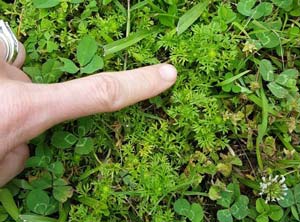Spurweed Control for Lawns
What is spurweed?

Spurweed, also known as stickers or burweed, is a winter annual weed. It is a tiny plant with parsley-like leaves and grows close to the soil line. Proper identification of spurweed is important, so check with your local extension office if you are in doubt. Spurweed germinates in the fall and winter months in lawn and turf areas, particularly in areas where turf is thin or patchy. During the winter, spurweed remains small and low-growing where it usually goes unnoticed until the plant matures.
In late winter, spurweed blooms are tiny white flowers. In the spring when temperatures begin to increase, the pollinated flowers of lawn spurweed begin to set fruit. The fruiting structures appear as small rosette buttons and develop in the leaf axils. As the fruit matures in mid to late spring, the seed in the fruiting structures develop spines, and when the fruit becomes dry, the spines become very sharp. These sharp spines are what make the lawn spurweed so undesirable.
As you walk across a turf area barefoot, more than likely you will notice any encounter with this weed, due to the painful spines that penetrate in the skin.
How can I control spurweed?
You can prevent spurweed by maintaining a healthy turf. A healthy turf competes for water, nutrients, and space. Fertility, irrigation, and mowing height can encourage a healthy turf that acts as a physical barrier, choking out many opportunistic weeds. If your managed turf site is a warm-season grass (like bermudagrass or zoysiagrass), it may be helpful to adjust your mower to its highest cutting height for the last cut of the season in fall, to ensure the thickest canopy is present over winter. This can prevent many winter annual weeds from developing. However, if spurweed is already present, it is critical to control before the fruiting structures develop, Otherwise, the burrs will persist as hazards in your turf and shed seeds to re-infest your property next year.
Spurweed can be easily controlled during the winter months of December, January, and February. This is the ideal time to apply herbicides for spurweed control, especially because warm-season turf species are dormant and not sensitive to many herbicide applications. In most areas of Arkansas, the weed can also be effectively controlled in March.
What herbicides should I use for spurweed control?
Preemergence herbicides that are effective on controlling spurweed are:
- atrazine (AAtrex, a Restricted Use Herbicide)
- simazine (Princep, others)
- isoxaben (Gallery)
- metribuzin (Sencor Turf)
This group of herbicides should not be used on bermudagrass over seeded with a cool-season turfgrass or on tall fescue,
as they are injurious to cool-season turfgrasses. Note that isoxaben is effective
for suppression of germinating spurweed seeds, so its application must be timed prior to germination in the Fall.
The best option to control spurweed by homeowners is a post-emergence application of one of the various two and three-way mixes of 2,4-D, dicamba and MCPP. Trimec is one of the most common trade names in this category. These products can be used on tall fescue, fall over seeded bermudagrass in which the over seeded cool-season grass has been mowed four to five times and non-over seeded bermudagrass.
How to apply herbicides for spurweed
The postemergence herbicides should be applied on a warm (air temperatures at least 55 degrees Fahrenheit), sunny day. Two to three weeks after the initial application, spurweed control should be evaluated. If control is not acceptable, an additional application may be necessary. Make sure to read the label before application to make sure the specific formulation and percentage of chemical that you choose is appropriate for your lawn and always follow mixing and sprayer instructions to insure effective control and proper use of the herbicide.
The reference to brand names in this article is not an endorsement of these products, as the University of Arkansas System Division of Agriculture Research & Extension does not endorse specific pesticide brands.